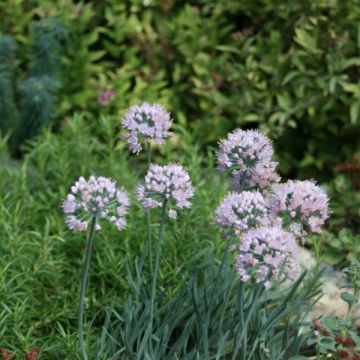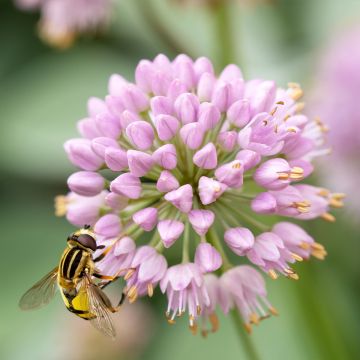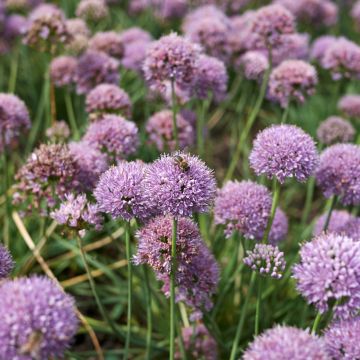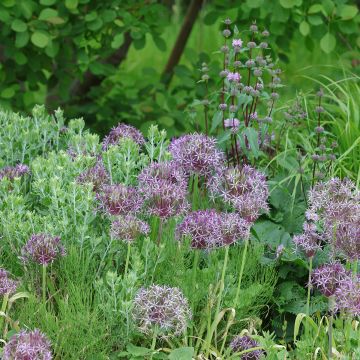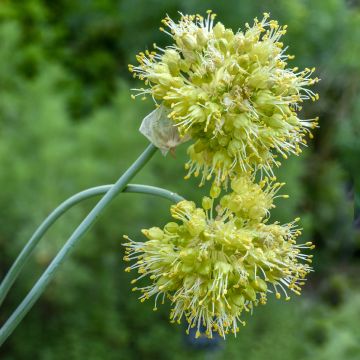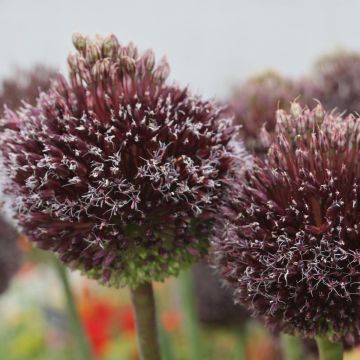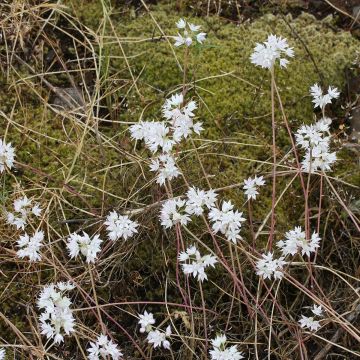Shipping country and language
Your country of residence may be:
Your country of residence is:
For a better user experience on our website, you can select:
Your shipping country:
Andorra
Austria
Belgium
Bulgaria
Canada
Chile
Croatia
Cyprus
Czechia
Denmark
Estonia
Finland
France
Germany
Greece
Hungary
Iceland
Ireland
Italy
Latvia
Lithuania
Luxembourg
Malta
Monaco
Netherlands
Poland
Portugal
Romania
Slovakia
Slovenia
Spain
Sweden
Switzerland
United Kingdom
We only deliver seed and bulb products to your country. If you add other products to your basket, they cannot be shipped.
Language:
French
German
Spanish
English
My Account
Hello
My wish lists
Plantfit
Log in / Register
Existing customer?
New customer?
Create an account to track your orders, access our customer service and, if you wish, make the most of our upcoming offers.


Art Chives - Allium scorodoprasum


Art Chives - Allium scorodoprasum
Art Chives - Allium scorodoprasum
Allium scorodoprasum Art
Sand Leek
Why not try an alternative variety in stock?
View all →Order in the next for dispatch today!
Dispatch by letter from €3.90.
Delivery charge from €5.90 Oversize package delivery charge from €6.90.
More information
This item is not available in your country.
Schedule delivery date,
and select date in basket
This plant carries a 12 months recovery warranty
More information
We guarantee the quality of our plants for a full growing cycle, and will replace at our expense any plant that fails to recover under normal climatic and planting conditions.
From €5.90 for pickup delivery and €6.90 for home delivery
Express home delivery from €8.90.
From €5.90 for pickup delivery and €6.90 for home delivery
Express home delivery from €8.90.
Does this plant fit my garden?
Set up your Plantfit profile →
Description
Allium scorodoprasum 'Art' is a variety of sand leek that deserves to be discovered by enthusiasts of ornamental garlics. Its inflorescences, slightly perplexing, are irregular heads mixing flowers and bulbils. It is the rose-crimson star-shaped flowers, whose petioles lengthen when they are fertilised, that give this garlic its curious appearance. The hardy bulb develops a sturdy stem that allows the umbel to withstand the wind. A charming and original cut flower, it is vigorous and long-lasting in well-drained, sunny soils.
Native to central Europe, particularly the Caucasus, Allium scorodoprasum is the wild form of rocambole garlic. It is a bulbous plant that prefers light and rather dry soil, with a tendency towards basic (calcareous) and clay soil, low in organic matter (humus, compost).
The 'Art' selection, registered in the Netherlands in 2009, has inflorescences measuring 4 to 5 cm (2in) in diameter, borne between 1 m (3ft) and 1.10 m (4ft) above the ground, on spiralled stems in their upper part. They are globular clusters surrounded by membranous bracts, consisting of bulbils that are initially green and become violet, and small purple star-shaped flowers on the outside, more pink on the inside. This flowering occurs between June and July. The foliage consists of 4 to 6 basal, tubular leaves with a strong sulfur smell. It turns yellow and disappears at the same time as the flowering appears, which is a good adaptation to hot and dry summer conditions. This plant produces only a few seeds and reproduces mainly through the dispersal of bulbils produced on the umbel.
Relatively easy to grow in full sun, Allium 'Art' appreciates any type of fresh soil during its growing period, but always well-drained. It is interesting in flower beds or borders and can also be grown in pots to enjoy its curious flowering on a balcony or patio. Enhance your bouquets with its fresh or dried flowers, they will bring a modern and unusual touch. Plant it in groups of 5 bulbs that you will slide between medium-sized grasses, tall light perennials like fennel, or near brooms. It will be perfectly at home in a flower meadow, in the company of poppies, corn poppies, love-in-a-mist, and other centaureas. For a graphic effect, combine it with buxus in ball shape. This edible garlic can also be planted in the vegetable garden to supply the cut flower reserve.
In the kitchen: all garlics are edible, in all their parts (bulb, leaves, flavorful flowers, which also decorate dishes and sauces).
Small vegetable garden tip: plant some ornamental garlics in the middle of strawberries to protect them from fungal diseases, they will bring some pleasant flowering that is sometimes missing among the vegetables.
Flowering
Foliage
Plant habit
Botanical data
Allium
scorodoprasum
Art
Amaryllidaceae
Sand Leek
Cultivar or hybrid
Other Allium
Planting and care
Allium scorodoprasum Art is relatively easy to grow in ordinary, well-drained soil, and can even tolerate dry conditions in summer. Plant the bulbs preferably before the end of October so that they have time to establish themselves. The plants in pots can be planted in spring. Alliums dislike winter moisture and waterlogged soils, which cause the bulbs to rot. Give them a sunny spot in well-drained, light, sandy, or even rocky soil. Plant them at a depth of 10 or 15 cm (4 or 6in), spaced 10 cm (4in) apart. Undemanding, they prefer soils that are not too fertile, but occasionally appreciate a slow-release fertiliser in very poor soils.
Planting period
Intended location
Care
This item has not been reviewed yet - be the first to leave a review about it.
Haven't found what you were looking for?
Hardiness is the lowest winter temperature a plant can endure without suffering serious damage or even dying. However, hardiness is affected by location (a sheltered area, such as a patio), protection (winter cover) and soil type (hardiness is improved by well-drained soil).

Photo Sharing Terms & Conditions
In order to encourage gardeners to interact and share their experiences, Promesse de fleurs offers various media enabling content to be uploaded onto its Site - in particular via the ‘Photo sharing’ module.
The User agrees to refrain from:
- Posting any content that is illegal, prejudicial, insulting, racist, inciteful to hatred, revisionist, contrary to public decency, that infringes on privacy or on the privacy rights of third parties, in particular the publicity rights of persons and goods, intellectual property rights, or the right to privacy.
- Submitting content on behalf of a third party;
- Impersonate the identity of a third party and/or publish any personal information about a third party;
In general, the User undertakes to refrain from any unethical behaviour.
All Content (in particular text, comments, files, images, photos, videos, creative works, etc.), which may be subject to property or intellectual property rights, image or other private rights, shall remain the property of the User, subject to the limited rights granted by the terms of the licence granted by Promesse de fleurs as stated below. Users are at liberty to publish or not to publish such Content on the Site, notably via the ‘Photo Sharing’ facility, and accept that this Content shall be made public and freely accessible, notably on the Internet.
Users further acknowledge, undertake to have ,and guarantee that they hold all necessary rights and permissions to publish such material on the Site, in particular with regard to the legislation in force pertaining to any privacy, property, intellectual property, image, or contractual rights, or rights of any other nature. By publishing such Content on the Site, Users acknowledge accepting full liability as publishers of the Content within the meaning of the law, and grant Promesse de fleurs, free of charge, an inclusive, worldwide licence for the said Content for the entire duration of its publication, including all reproduction, representation, up/downloading, displaying, performing, transmission, and storage rights.
Users also grant permission for their name to be linked to the Content and accept that this link may not always be made available.
By engaging in posting material, Users consent to their Content becoming automatically accessible on the Internet, in particular on other sites and/or blogs and/or web pages of the Promesse de fleurs site, including in particular social pages and the Promesse de fleurs catalogue.
Users may secure the removal of entrusted content free of charge by issuing a simple request via our contact form.
The flowering period indicated on our website applies to countries and regions located in USDA zone 8 (France, the United Kingdom, Ireland, the Netherlands, etc.)
It will vary according to where you live:
- In zones 9 to 10 (Italy, Spain, Greece, etc.), flowering will occur about 2 to 4 weeks earlier.
- In zones 6 to 7 (Germany, Poland, Slovenia, and lower mountainous regions), flowering will be delayed by 2 to 3 weeks.
- In zone 5 (Central Europe, Scandinavia), blooming will be delayed by 3 to 5 weeks.
In temperate climates, pruning of spring-flowering shrubs (forsythia, spireas, etc.) should be done just after flowering.
Pruning of summer-flowering shrubs (Indian Lilac, Perovskia, etc.) can be done in winter or spring.
In cold regions as well as with frost-sensitive plants, avoid pruning too early when severe frosts may still occur.
The planting period indicated on our website applies to countries and regions located in USDA zone 8 (France, United Kingdom, Ireland, Netherlands).
It will vary according to where you live:
- In Mediterranean zones (Marseille, Madrid, Milan, etc.), autumn and winter are the best planting periods.
- In continental zones (Strasbourg, Munich, Vienna, etc.), delay planting by 2 to 3 weeks in spring and bring it forward by 2 to 4 weeks in autumn.
- In mountainous regions (the Alps, Pyrenees, Carpathians, etc.), it is best to plant in late spring (May-June) or late summer (August-September).
The harvesting period indicated on our website applies to countries and regions in USDA zone 8 (France, England, Ireland, the Netherlands).
In colder areas (Scandinavia, Poland, Austria...) fruit and vegetable harvests are likely to be delayed by 3-4 weeks.
In warmer areas (Italy, Spain, Greece, etc.), harvesting will probably take place earlier, depending on weather conditions.
The sowing periods indicated on our website apply to countries and regions within USDA Zone 8 (France, UK, Ireland, Netherlands).
In colder areas (Scandinavia, Poland, Austria...), delay any outdoor sowing by 3-4 weeks, or sow under glass.
In warmer climes (Italy, Spain, Greece, etc.), bring outdoor sowing forward by a few weeks.




